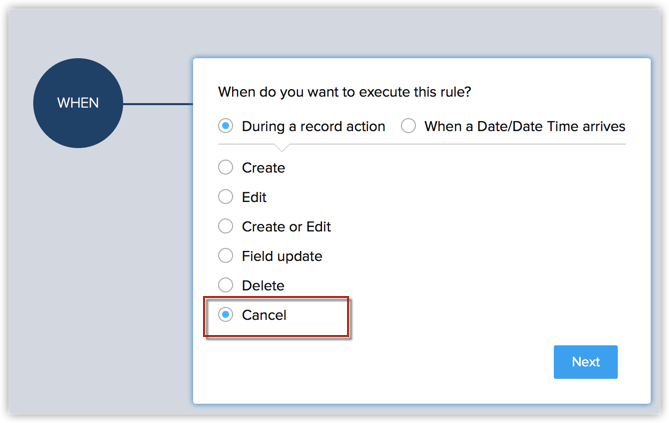Create Workflow Rules in Nonprofit Vertical CRM
Workflow Rules in Nonprofit Vertical CRM, are a set of actions (alerts, tasks and field updates) that are executed when certain specified conditions are met. These rules automate the process of sending email alerts, assigning tasks and updating certain fields of a record when a rule is triggered.
A workflow rule consists of the following elements:
- Basic Details - Specify details on the record type for which the rule applies, rule name, description.
- Rule Trigger- Specify when the rule should be triggered for a record and based on what. There are two options:
- Execute based on a record's action - Rules can be triggered when records are created, edited, created/edited, deleted or a specific fields are updated.
- Execute based on a date field's value - For all the records matching the rule criteria, rule will be triggered either monthly or yearly based on the value of the date field that is selected.
- Execute based on a record's action - Rules can be triggered when records are created, edited, created/edited, deleted or a specific fields are updated.
- Rule Criteria - List out the criteria to filter out records that meet the criteria. Workflow rule is triggered to these records.
- Actions - Specifiy the action to be automated for records that meet the set criteria.
- Instant Actions - Add alerts, tasks, field updates, webhooks and custom functions that will be triggered immediately when the rule is executed. On Edit or Field Update actions, you can also convert Leads, Quotes or Sales Orders.
- Scheduled Actions - Add alerts, tasks, field updates, webhooks and custom functions that will be scheduled and triggered based on a specified time.
- Instant Actions - Add alerts, tasks, field updates, webhooks and custom functions that will be triggered immediately when the rule is executed. On Edit or Field Update actions, you can also convert Leads, Quotes or Sales Orders.
Create Workflow Rules in Nonprofit Vertical CRM
The steps to create a workflow rule are divided into 4 parts.
Part 1 - Enter the basic details of the rule
- Click
 (the Settings icon) > Setup > Automation > Workflow Rules.
(the Settings icon) > Setup > Automation > Workflow Rules. - In the Workflow Rules page, click Create Rule.
- In the Create New Rule popup, do the following:
- Select the Module to which the rule applies from the drop-down list.
- Enter the Rule Name and Description.
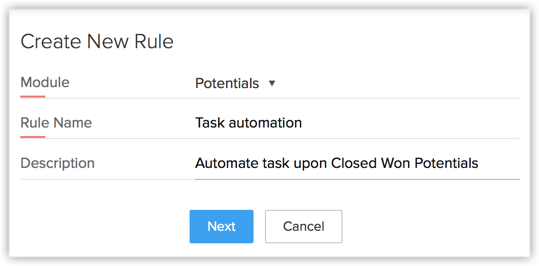
- Select the Module to which the rule applies from the drop-down list.
- Click Next.
Part 2 - Specify the rule trigger
There are two options based on which the rule will be triggered for a record that matched the rule criteria. One of these options need to be selected when you create a workflow rule and you cannot change it later by editing the rule. They are
- A Record Action - Rules can be triggered when records are created, edited, created/edited, deleted or a specific fields are updated.
- A Date Field's Value -For all the records matching the rule criteria, rule will be triggered either monthly or yearly based on the value of the date field that is selected. This option is available only in the Enterprise Edition.
Execute Based on Record Action
When new leads are created in Nonprofit Vertical CRM you may want to automatically send an email or a series of emails at set intervals. You may also want to create tasks for these new leads. Also, sometimes when specific fields are updated, you may want to trigger a workflow. This execution option lets you specify an action (Create, Edit, Delete, etc.) based on which workflow rules will be triggered.
- Select one of the following:
- Create: Executes the rule when records are created.
- Edit: Executes the rule when existing record are modified.
- Create or Edit: Executes the rule when records are created or existing records are modified.
- Field Update: Executes the rule when the values of the specified fields are modified in a record.
- Delete: Executes the rule when certain records are deleted. Only Workflow Alerts and Webhooks can be associated for such a rule. The action includes:
- Deleting a record from the Details Page.
- Deleting from the List View (One by one or in bulk).
- Using the Mass Delete feature.
- Deleting from a record's Related List. For example, deleting a contact under an Account.
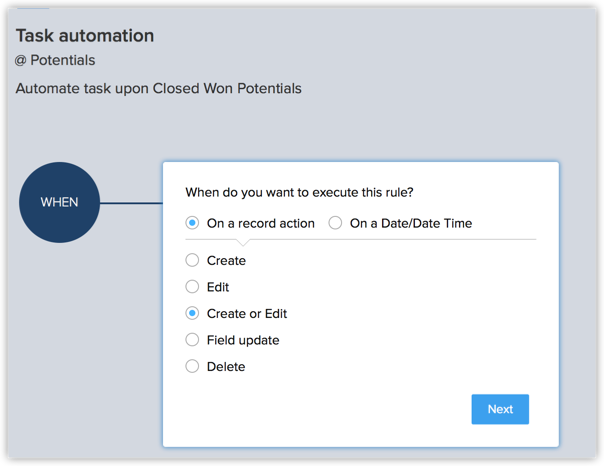
- Deleting a record from the Details Page.
- Create: Executes the rule when records are created.
- When you select the Field Update option, do the following:
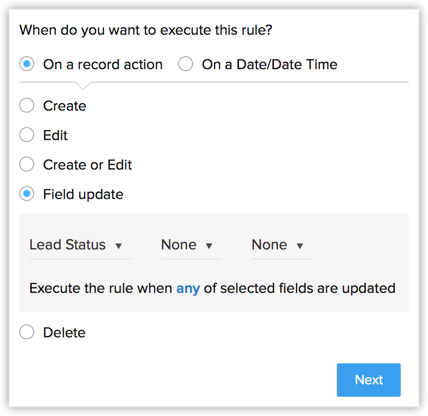
- Choose the field name from the drop-down lists.
- Choose one of the following:
- Execute the rule when all the selected fields are updated.
- Execute the rule when any selected field is updated.
- Execute the rule when all the selected fields are updated.
- Choose the field name from the drop-down lists.
- Click Next.
Execute Based on Date Field's Value
You may want to get an email reminder a week before a deal's expected closing date, or may want to send an email to the customers reminding them of the monthly rentals or subscription renewals. In these cases, it is not necessary that the records should be created or edited for the rule to get triggered. It is plainly based on the value in the date fields. This execution option lets you pick a date field from a record and allows you to define the day for the rule to be triggered. Please note, with this option, a maximum of 3000 records will be triggered every hour. If there are more than 3000 records, the remaining records will be executed in the next hour. Please note, this option is available only in the Enterprise Edition.
- Choose a Date field from the drop-down list.All the date fields in the module for which the rule is being created will be listed.
- Choose On, Before or After from the drop-down list to set the Date of Execution.The rule can be set to trigger a maximum of 90 days Before or After the Date field specified.
- Specify the time of execution in hours and minutes.In case of DateTime fields, there is an option to trigger the rule based on the time in the field value.
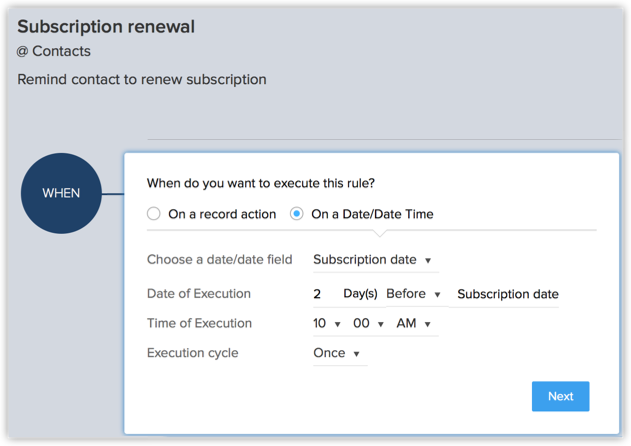
- Select the Execution cycle as Once, EveryMonth or EveryYear.
- Click Next.
Part 3 - Set rule criteria
- In the Rule Criteria section, specify the rule criteria details.
- Click Add Criteria to add multiple criteria.
- Click Next.
Edit Criteria Patterns
Criteria Pattern Editor in the custom list view helps you to develop the advanced filters using simple logical operators like and / or.
To edit criteria patterns
- Click Settings> Setup > Automation > Workflow Rules.
- In the Workflow Rules page, click on a workflow rule.
- In the Edit Rule page, review your existing criteria and click the Change Pattern link.
- In Pattern Editor box, modify filters and click the Save link.
- Save the modified custom view.
Type is New Business; Stage is Need Analysis or Qualification; and Amount > $50000.
You can create this criteria easily using the Criteria option given below: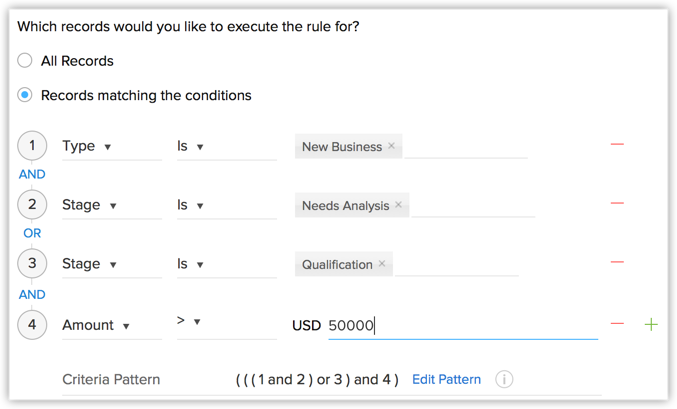


You can use the following characters in the Criteria Pattern Editor:
- Round brackets: ( )
- and / or operators
- Criteria Row Number
Important Notes
- When the Change Pattern box is being used to edit, you cannot add or delete a criteria row under the Specify Criteria section.
- The operator precedence will not be taken into account if you do not specify brackets. For example, if you specify the criteria as 1 or 2 and 3, it will be considered as ((1 or 2) and 3)
- You can change the and or or of the criteria rows and it will be updated in the Editor below.
- You can change the and or or condition in the pattern and it will be updated in the rows above.
- If you specify 1 and 2 and save it, on editing the view the pattern will be shown as (1 and 2). For (1 and 2) or 3the pattern will be shown as ( (1 and 2) or 3 )
- If you add more rows in the editor and delete one by one there will be additional brackets displayed in the pattern. For example if there are 4 rows added and you delete the 3rd row, the criteria pattern will be as ( ( ( ( 1 and 2 ) ) ) or 3 ). If the first row is deleted then it will be shown as ( ( ( ( 1 ) ) ) or 2 ). However, on saving the criteria, it will change as ( 1 or 2 ).
- Make sure that you do not use the following as they are invalid: (), (and), (or).
- If the brackets do not match it will be treated as invalid.
- There will an error message, if the number of rows and the numbers given in the pattern do not match and also, if there are any numbers missed in the pattern.
- In case the final brackets are missing, there will be a difference in the Criteria Patterns Editor and its view mode.
Your Criteria Pattern in Editor Your Criteria Pattern in View Mode ( 1 and 2 ) or ( 3 and 4 ) (( 1 and 2 ) or ( 3 and 4 )) 1 and 2 and 3 and 4 (1 and 2 and 3 and 4 ) ( 1 or 2 ) and ( 3 or 4 ) ( ( 1 or 2 ) and ( 3 or 4 ) )
Part 4 - Associate instant and/or scheduled actions
Workflow rules are meaningful only if an alert, task, field update, webhook or custom function is associated to the rule. They are grouped under Actions that can either be Instant Actions or Scheduled Actions. These actions once created, can be associated with many rules.
- In the Actions section, do the following:Note that you cannot save a rule without creating either an instant or a scheduled action.
- Create Instant Action by associating alerts, tasks, field updates, webhooks or custom functions. See AlsoCreate Instant Actions
- Create Scheduled Actions and associate alerts, tasks, field updates, webhooks or custom functions. See Also Create Scheduled ActionsA maximum of 5 scheduled actions can be created.
- Create Instant Action by associating alerts, tasks, field updates, webhooks or custom functions. See AlsoCreate Instant Actions
- Click Save.
Associate Actions to Rules
Create Instant Actions
Instant action includes alerts, tasks, field updates, webhooks and custom functions that are triggered immediately when the rule is executed. There are two options to associate these actions.
- Create alerts, tasks, field updates, webhooks or custom functions and associate them to the rule. You can also create an action to convert leads, quotes or sales orders.
- Select existing alerts, tasks, field updates, webhooks or custom functions to associate to the rule.
To create an instant action
If you are creating a workflow rule, directly go to step 4
- Click
 (the Settings icon) > Setup > Automation > WorkflowRules.
(the Settings icon) > Setup > Automation > WorkflowRules. - In the Workflow Rules page, click on the rule for which you want to create an action.
- Click Edit to modify the rule settings.
- Under Instant Actions section, do the following to associate alerts, tasks, field updates, webhooks or custom functions to the rule:
- In the corresponding section, click (the Add icon) and specify the details to create a record and associate it to the rule.
- In the corresponding section, click (the Associate icon) and select an existing record and associate it to the rule.
- In the corresponding section, click (the Add icon) and specify the details to create a record and associate it to the rule.
- Click Save.
Create Scheduled Actions
Scheduled actions include alerts, tasks, field updates, webhooks and custom functions that are triggered on a specified time after the rule is executed. You can schedule the actions to be triggered based on the Rule Trigger Date, record Created Time, record Modified Time as well as other time or date fields in the module. You can see the list of scheduled actions for individual records under "Upcoming Actions".
There are two options to associate these actions.
- Create alerts, tasks, field updates, webhooks or custom functions and associate them to the rule.
- Select existing alerts, tasks, field updates, webhooks or custom functions to associate to the rule.
To create scheduled actions
If you are creating a workflow rule, directly go to step 4
- Click
 (the Settings icon) > Setup > Automation > WorkflowRules.
(the Settings icon) > Setup > Automation > WorkflowRules. - In the Workflow Rules page, click on the rule for which you want to create an action.
- Click Edit to modify the rule settings.
- Under the Actions section, click Add a Scheduled Action.
- Enter a Name for the scheduled action.
- Specify the Execution Time, i.e. when the associated actions should be triggered.
- Click Save.
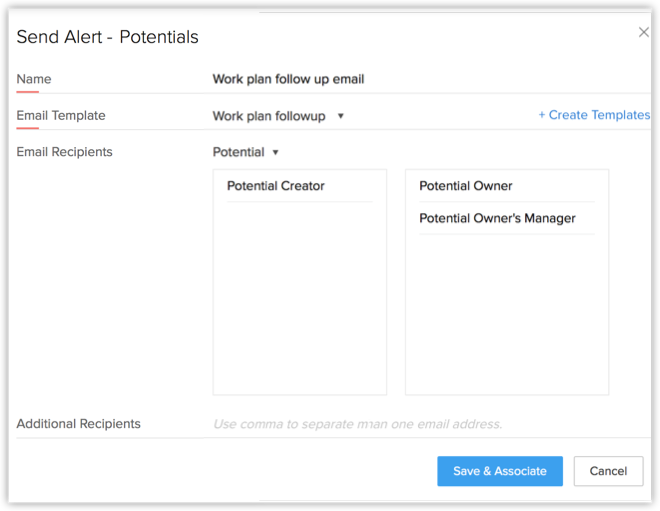
- Under Scheduled Actions section, do the following to associate alerts, tasks, field updates, webhooks or custom functions to the rule:
- In the corresponding section, click (the Add icon), specify the details to create a record and associate it to the rule.
- In the corresponding section, click (the Associate icon), select an existing record and associate it to the rule.
- In the corresponding section, click (the Add icon), specify the details to create a record and associate it to the rule.
- Click Save.
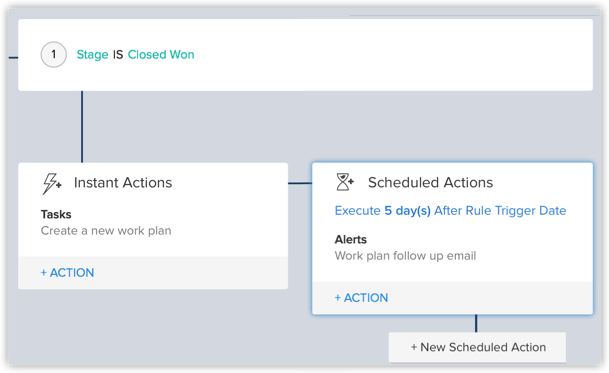
Instances when the scheduled actions will be rescheduled:
- The Execution Criteria for the Rule is either Edit or Create or Edit. When the rule criteria is satisfied for a record, the instant actions are triggered and scheduled actions are scheduled for the record.If a user edits the record and the rule criteria is not fulfilled, then the scheduled actions scheduled earlier will be deleted. If the record is edited again and the criteria is satisfied, then the scheduled actions will be rescheduled.
- For Scheduled Actions, the Execution Time can also be based on the custom Date & Time field. When a rule criteria is satisfied for a record, the instant actions are triggered and scheduled actions are scheduled for the record.If a user edits the record to change the value of the date & time field, the scheduled actions will be rescheduled as per the new date & time value.
Instances when scheduled actions will be deleted or not be rescheduled:
- The Execution Criteria for the Rule is either Edit or Create or Edit. When the rule criteria is satisfied for a record, the instant actions are triggered and scheduled actions are scheduled for the record.If a user edits the record but the rule criteria is not fulfilled, then the scheduled actions will not be scheduled again.
- When the Enterprise Edition is downgraded to the Free Edition, all the scheduled actions that are scheduled for the record will be deleted.
- When records are deleted, all the scheduled actions scheduled to the record will also be deleted. If the deleted records are restored, the scheduled actions will not be rescheduled.
Instances when the Scheduled actions will not be executed:
- When an event is canceled, all the scheduled actions scheduled for the event will not be executed.
- When a lead is converted, all the scheduled actions scheduled for the record will not be executed.
Lock Workflow Rules
When you want to make sure that no one edits a workflow rule unless absolutely necessary, you can lock the rule. When a rule is locked, it cannot be edited. One has to unlock the rule in order to edit it again. A locked rule sends out the message to fellow administrators that it is not meant to be edited unless absolutely required. A workflow rule can be locked after it has been created.
To lock a workflow rule
- Click
 (the Settings icon) > Setup > Automation > Workflow Rules.
(the Settings icon) > Setup > Automation > Workflow Rules. - From the Workflow Rules list view under the Rules tab, click the rule that you wish to lock.
- In the selected workflow rule details page, click the Lock icon next to the rule name.
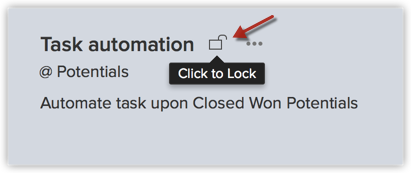
- In the Lock Rule popup, enter the reason for locking the rule. This message will be displayed to fellow administrators who are trying to unlock the rule for editing.
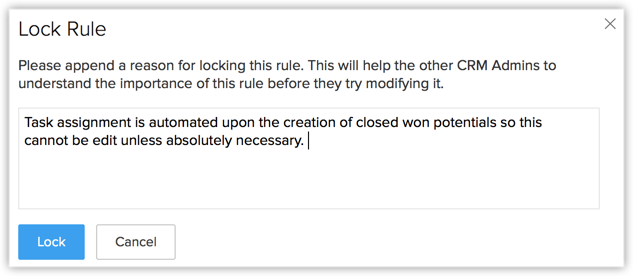
- Click Lock.The rule is now locked for editing.
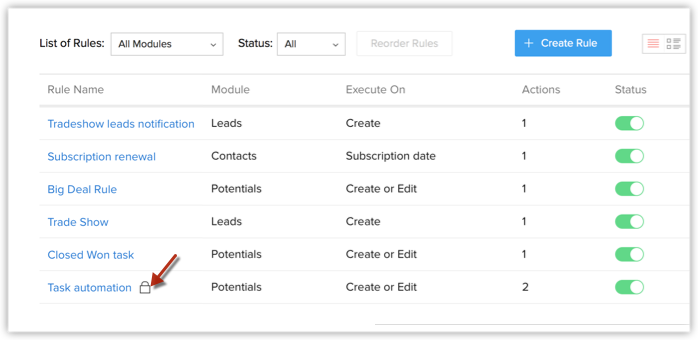
Use List View & Summary View
There are two views for workflow rules that are created - the List View and the Summary View. By default, you will see the list view, which is a list of all the workflow rules for All modules/Selected module.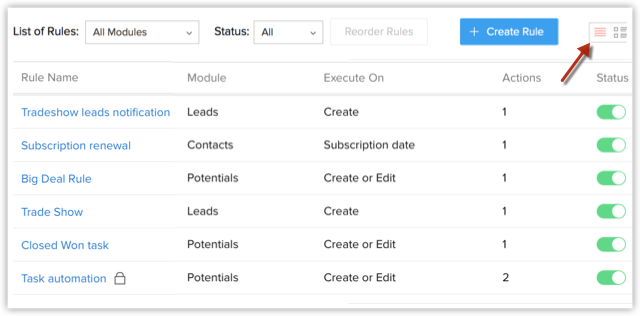
The Summary view lists out the Criteria and Field Updates associated to the rules that will help you get a clear picture of all the rules and where they are used to avoid any confusion.
To use summary view
- Click
 (the Settings icon) > Setup > Automation > Workflow Rules.
(the Settings icon) > Setup > Automation > Workflow Rules. - In the Workflow Rules page, select a module from the drop-down list.
- Click Summary View icon.All the rules for the selected module will be listed along with the Criteria and the associated Field Updates. You can click the Show More link to see the other items associated to the rule.
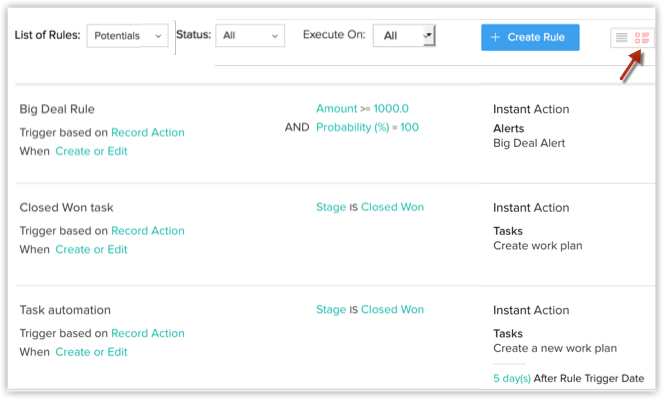
To reorder the workflow rules
- Click
 (the Settings icon) > Setup > Automation > Workflow Rules.
(the Settings icon) > Setup > Automation > Workflow Rules. - In the Workflow Rules page, select a module from the drop-down list.Make sure you have selected the List View and not the Summary View.
- Click Reorder Rules.
- Drag and drop the rules in the order that you require.
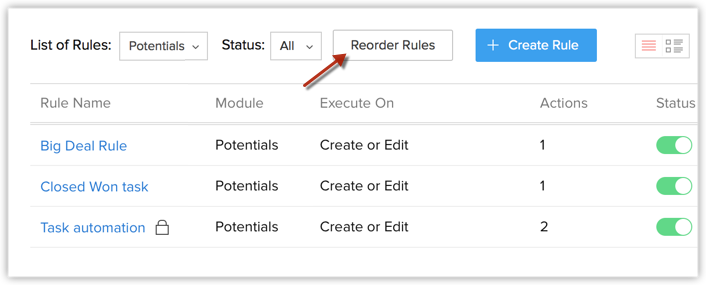
Delete Workflow Rules
Workflow rules can be deactivated when not in use. You can also delete the unwanted workflow rules.
To delete workflow rules
- Click
 (the Settings icon) > Setup > Automation > Workflow Rules.
(the Settings icon) > Setup > Automation > Workflow Rules. - In the Workflow Rules page, click the Delete icon for the corresponding rule.
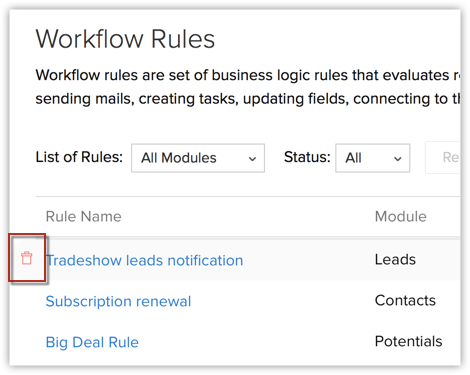
Related Articles
Configuring Workflow Rules
Workflow Rules in Nonprofit Vertical CRM, are a set of actions (email notifications, tasks and field updates) that are executed when certain specified conditions are met. These rules automate the process of sending email notifications, assigning ...Setting Up Nonprofit Vertical CRM
Setting up Nonprofit Vertical CRM for your Organization The Setup page in Nonprofit Vertical CRM helps you configure all settings necessary to get your CRM up and running. Be it personalization, automation or third-party integrations, you can ...Workflow Tasks
Workflow Tasks are among the actions associated to a workflow rule. A task is an activity that is assigned to a user. When you associate a workflow task to a workflow rule, it is automatically assigned to the user when the rule is triggered for the ...Nonprofit Vertical CRM Common Operations
How Can I... · Navigate Records · Search Records · Create Records · Create Records Individually · Import Records · Capture Records from Website (Using Web-to-record Form) · Export Records · Print Records · Restore Deleted Records · Merge Duplicate ...Setting Up Assignment Rules
Assignment rules help you automatically assign the records to users in Nonprofit Vertical CRM. The assignment rule is applicable only for the leads, contacts, cases and records in custom modules that are imported or the ones that are captured through ...
